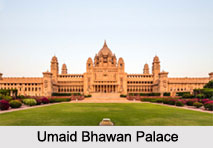 Tourism in Jodhpur is nourished with popular tourism attractions like Mehrangarh Fort, Umaid Vilas Palace, Chamunda Devi Temple, Jaswant Thada, Mandore Gardens, Kailana Lake and many others.
Tourism in Jodhpur is nourished with popular tourism attractions like Mehrangarh Fort, Umaid Vilas Palace, Chamunda Devi Temple, Jaswant Thada, Mandore Gardens, Kailana Lake and many others.
Mehrangarh Fort
Mehrangarh Fort is the oldest fort in Jodhpur. This fort in Jodhpur is enclosed by thick walls. This fort has seven gates. One such gate was dedicated to mark the defeat of the Mughals.
Umaid Bhawan Palace
Umaid Bhawan Palace is now a heritage hotel and it has an exclusive collection of Rajasthani paintings belonging to the Rajasthani Schools of Painting.
Khejarla Fort
Khejarla Fort is set in the midst of the village settlements. It is now also converted into a hotel. This fort is an eminent example of Rajput art and architecture.
Phool Mahal
Phool Mahal was constructed by Abhay Singh. Phool Mahal was used as a private audience hall and there present the portraits of several classical musicians of India.
Jhanki Mahal
Jhanki Mahal is known as the abode of royal ladies to watch the official proceedings in the court of the kings. Located in the courtyard of Mehrangarh Fort, it has been converted into a museum.
Moti Mahal
Moti Mahal is filled with the latticed windows (jali windows). The work is so fine that from a distance it seems that they are made of lace.
Chamunda Devi Temple
Chamunda Devi Temple is dedicated to Goddess Chamunda. The idol was brought by Rao Jodha but it was destroyed in an explosion. The idol was reconstructed by Takhat Singh.
 Jaswant Thada
Jaswant Thada
Jaswant Thada is known as the royal crematorium of Jaswant Singh II. Built in all white marble, it is situated in close proximity to Mehrangarh Fort. This monument was built in 1899. The portraits of various rulers of Jodhpur are also placed here.
Jodhpur Government Museum
Jodhpur Government Museum is a museum located in Umaid Gardens. This museum is the collection house of many royal relics.
Ghanta Ghar
Ghanta Ghar also known as the clock tower is located near the busy market area of Jodhpur.
Mahamandir Temple
Mahamandir Temple was constructed in 1812. Besides being a place of worship it is also an architectural delight. Mahamandir Temple is supported by 84 pillars.
Sardar Samand Palace
Sardar Samand Palace is the hunting lodge of the royal families of Jodhpur. This house has the vast collection of Rajasthani paintings.
Ranisar Padamsar
Ranisar and Padmasar are two adjacent artificial lakes that were constructed in the year 1459. These lakes were constructed to cool down the temperature of the fort and the nearby villages.



















